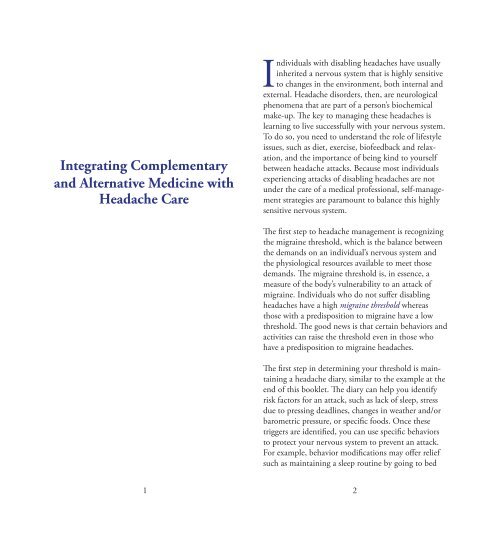for Headache Treatment
Alternative-Therapy-Brochure
Alternative-Therapy-Brochure
You also want an ePaper? Increase the reach of your titles
YUMPU automatically turns print PDFs into web optimized ePapers that Google loves.
Integrating Complementary<br />
and Alternative Medicine with<br />
<strong>Headache</strong> Care<br />
Individuals with disabling headaches have usually<br />
inherited a nervous system that is highly sensitive<br />
to changes in the environment, both internal and<br />
external. <strong>Headache</strong> disorders, then, are neurological<br />
phenomena that are part of a person’s biochemical<br />
make-up. The key to managing these headaches is<br />
learning to live successfully with your nervous system.<br />
To do so, you need to understand the role of lifestyle<br />
issues, such as diet, exercise, biofeedback and relaxation,<br />
and the importance of being kind to yourself<br />
between headache attacks. Because most individuals<br />
experiencing attacks of disabling headaches are not<br />
under the care of a medical professional, self-management<br />
strategies are paramount to balance this highly<br />
sensitive nervous system.<br />
The first step to headache management is recognizing<br />
the migraine threshold, which is the balance between<br />
the demands on an individual’s nervous system and<br />
the physiological resources available to meet those<br />
demands. The migraine threshold is, in essence, a<br />
measure of the body’s vulnerability to an attack of<br />
migraine. Individuals who do not suffer disabling<br />
headaches have a high migraine threshold whereas<br />
those with a predisposition to migraine have a low<br />
threshold. The good news is that certain behaviors and<br />
activities can raise the threshold even in those who<br />
have a predisposition to migraine headaches.<br />
The first step in determining your threshold is maintaining<br />
a headache diary, similar to the example at the<br />
end of this booklet. The diary can help you identify<br />
risk factors <strong>for</strong> an attack, such as lack of sleep, stress<br />
due to pressing deadlines, changes in weather and/or<br />
barometric pressure, or specific foods. Once these<br />
triggers are identified, you can use specific behaviors<br />
to protect your nervous system to prevent an attack.<br />
For example, behavior modifications may offer relief<br />
such as maintaining a sleep routine by going to bed<br />
1<br />
2



